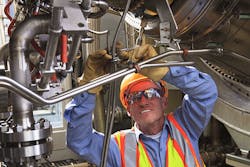Contractor Safety: Are You Responsible When They Are on Site?
Countries have different rules and regulations when it comes to safety and training for contracted companies and lone workers.
Globally, the International Labour Organization (ILO) reports that “although there are no ILO instruments that specifically address contractors’ and subcontractors’ safety and health at work (or for training in the industry), those concerning occupational safety and health (OSH) in general emphasize the importance of OSH training for all workers. Safety training should focus on supporting preventive action and finding practical solutions.”
While there are no specific global requirements, we will explore contractor safety regulations for the construction industry in the United States, United Kingdom, Canada and Australia.
United States
OSHA offers safety and health regulations for construction. According to the regulations for construction, “in no case shall the prime contractor be relieved of overall responsibility for compliance with the requirements of this part for all work to be performed under the contract.”
Workers in the engineering and construction industries face many hazards, as construction sites are one of the most dangerous places to work in the world, especially for contracted lone workers.
OSHA also indicates that “to the extent that a subcontractor of any tier agrees to perform any part of the contract, he also assumes responsibility for complying with the standards in this part with respect to that part… [W]ith respect to subcontracted work, the prime contractor and any subcontractor or subcontractors shall be deemed to have joint responsibility.”
In 2013, OSHA noted that 20 percent of occupational fatalities were in construction. Every month, the agency reports fatalities of contract workers, and often, publicizes citations and fines for both host companies and the employers of contract employees if they are killed or injured or endangered on the job.
United Kingdom
The UK’s Health & Safety Executive (HSE) reported that 31 percent of workplace fatalities were construction-related in 2013.
HSE provides multiple resources for contractors in the construction industry and states: “If you are contracting construction work you have duties as a client under the construction design and management regulations 2007 (CDM).”
The Construction Design and Management Regulations (CDM) offers a guidance for managing health and safety in construction called CDM 2015: Guidance on Regulations and explains it in more detail. HSE currently is determining whether to replace this guidance with an approved code of practice, which many in the industry indicated they would prefer when surveyed in 2014.
Using Contractors: A Brief Guide states, “Both you and the contractor you use have responsibilities under health and safety law. Everyone needs to take the right precautions to reduce the risks of workplace dangers to employees and the public. Make sure everyone understands the part they need to play in ensuring health and safety.”
Canada
The Canadian Centre for Occupational Health and Safety (CCOHS) reports some instances where employers were found to not protect the safety of their contractors – with fatal results.
“On June 12, 2006, a landscape contractor was crushed to death when the backhoe his employer was driving failed to stop, pinning the employee to a wall. The investigation of the incident found that the 30-year-old backhoe had not received any regular maintenance since the vehicle was purchased and that no formal inspection had been done in the previous five years. Upon further investigation it was discovered that the vehicle had no braking capacity. In September 2010, the employer was convicted of criminal negligence causing death and was given a two-year conditional sentence to be served in the community.”
In the province of British Columbia, WorkSafe BC’s prime contractor responsibilities state that at most multiple-employer work sites, “the prime contractor is responsible for health and safety” and offers advice for contractors to protect themselves and take preventative safety measures:
- Get it in writing.
- Identify, address and correct hazards.
- Communicate and coordinate with subcontractors.
- Assign a qualified coordinator.
- Establish an emergency response plan.
- Maintain accurate records.
Essentially, it’s best for both employer and contractor to take the above tips into consideration when working together.
Australia
The Australian government has implemented multiple safety measures for determining whether a contractor even qualifies as an “independent contractor” in the country.
According to the government, “If you hire independent contractors, you are legally responsible for ensuring their health and safety at all times while in your workplace (to the extent that this is reasonably practicable). For example, you should ensure that your workplace, any machinery, substances and facilities used are safe, and that all workers have adequate training, supervision and are properly licensed if required.”
According to the Health & Safety Handbook, “have a duty of care for the health and safety of a contractor’s workers when they are performing work on your worksite. This is your general duty of care under health and safety legislation and is non-delegable, meaning that it is a duty that you cannot contract out or transfer over to another party, e.g. a contractor. In principle, you therefore owe the same duties to contractors and their workers as you do to your own workers.”
The Safety Landscape is Evolving: Are you Prepared?
In the United Kingdom and Australia, the governments have implemented legislation that requires the employers to be responsible for the safety and well being of their contractors.Canada and the United States still have some work to do so that contractor responsibility is clear for both employers and contractors.
Is your organization up-to-date on local and regional legislation? Is this information effectively communicated – specifically to your lone workers? And are your current safety investments compliant?
About the Author: Kelly Meyers is with Blackline Safety, a supplier of wirelessly connected worker safety monitoring. Their solutions enable employers to monitor personnel working alone in populated areas, indoors within complex facilities and employees operating in remote areas.
